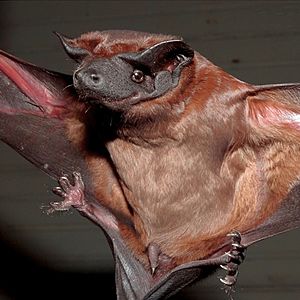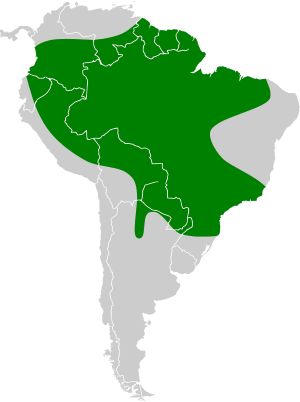Cinnamon dog-faced bat facts for kids
Quick facts for kids Cinnamon dog-faced bat |
|
|---|---|
 |
|
| Preserved specimen in the Naturalis Biodiversity Center | |
| Conservation status | |
| Scientific classification | |
| Genus: |
Cynomops
|
| Species: |
abrasus
|
 |
|
The cinnamon dog-faced bat (scientific name: Cynomops abrasus) is a type of bat that lives in South America. It belongs to a family of bats called Molossidae, often known as free-tailed bats. You can find this bat in many parts of northern and central South America.
Contents
About the Cinnamon Dog-Faced Bat
What's in a Name?
The cinnamon dog-faced bat is part of a group, or genus, called Cynomops. This group was recently separated from another bat group called Molossops. Think of a genus as a smaller family within the larger bat family.
There are four different types, or subspecies, of the cinnamon dog-faced bat:
- Cynomops abrasus abrasus (named by Temminck in 1827)
- C. a. brachymeles (named by Peters in 1866)
- C. a. cerastes (named by Thomas in 1901)
- C. a. mastivus (named by Thomas in 1911)
How to Spot One
These bats have fur that can be brown, dark brown, or a reddish-brown color, like cinnamon! Their belly fur is usually the same color as their back.
They have special patches of fur on their wings. One patch is on the top, back part of their forearm and the skin connecting their arm to their body. Another patch is on the bottom, back part of their forearm, stretching towards their wrist. These fur patches are darker than the rest of their wing skin.
The cinnamon dog-faced bat has a wide face with ears that are set far apart. They don't have wrinkles on their lips or a special nose leaf, which some other bats have.
Male and female bats of this species look a bit different in size. This is called sexual dimorphism.
- On average, these bats are about 121.1 mm (4.77 in) long from head to tail.
- Their tail is usually around 37.6 mm (1.48 in) long.
- A male bat's forearm (the main bone in their wing) is typically 44.2–49.0 mm (1.74–1.93 in) long.
- A female's forearm is a bit shorter, usually 41.0–45.0 mm (1.61–1.77 in) long.
- The length of a male's skull is about 19.5–24.3 mm (0.77–0.96 in).
- A female's skull is smaller, around 18.4–21.5 mm (0.72–0.85 in).
What They Eat
The cinnamon dog-faced bat is an insectivore, which means it eats insects. They especially like to munch on insects that have hard shells. They are known as "open-air hunters" because they catch their food while flying in open spaces.
Where They Live
Habitat and Distribution
You can find the cinnamon dog-faced bat on the eastern side of the Andes Mountains. Their home range includes many countries in South America, such as northern Argentina, Bolivia, Brazil, Colombia, Ecuador, French Guiana, Guyana, Peru, Paraguay, Suriname, and Venezuela.
These bats prefer to live in forests, especially high and dense ones. In places like Paraguay, they can be found near areas that often flood.
Bat Homes
Cinnamon dog-faced bats live together in groups called colonies. These colonies can have up to 75 bats! They like to make their homes, called roosts, inside old, decaying logs or hollow trees. They often choose warmer spots for their roosts.
Protecting the Bat
The International Union for Conservation of Nature (IUCN) lists the cinnamon dog-faced bat as "data-deficient." This means we don't have enough information about how many of these bats there are or exactly where they live. Because of this, it's hard to know if their numbers are going up or down.
One possible threat to these bats is deforestation. This is when forests are cut down for other uses, like farming or building. Since these bats rely on forests for their homes and hunting grounds, losing their habitat could be a big problem for them. Scientists and conservationists are working to learn more about this bat to help protect its future.
See also
 In Spanish: Moloso rojizo para niños
In Spanish: Moloso rojizo para niños


